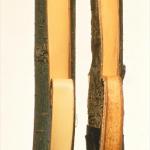Elm Yellows
A phytoplasma from the group provisionally named 'Candidatus Phytoplasma ulmi' causes elm yellows.
Host plants
Several native elm (Ulmus) species including American (Ulmus americana), slippery (U. rubra), and winged elm (U. alata) are susceptible to elm yellows.
Description
Elm yellows symptoms begin in mid to late summer with the chlorosis and drooping of petioles of turgid leaves and premature leaf loss. Generally, symptoms abruptly appear within a few weeks and are visible throughout the crown, but occasionally yellowing will begin on scattered branches and over a couple of years spread throughout the crown. In some situations, trees wilt and die quickly without prior symptoms. Within lower branches the inner bark (phloem) yellows (instead of the normal white color), then develops tan flecks, and eventually dies.
The smell of wintergreen is present in the inner bark/phloem tissues of living American and winged elm infected with elm yellows. On the other hand, the inner bark of slippery elm with elm yellows smells like maple syrup.
Disease Cycle
The entire process of spread and infection by the elm yellows phytoplasma is yet unclear. The white-banded elm leafhopper (Scaphoideus luteolus) is a known carrier of the phytoplasma, while other leafhoppers and spittlebugs can transmit the disease to test plants. The elm yellows phytoplasma persists in the roots of American elm. When new growth begins in the spring, insect carriers acquire the phytoplasma when they feed on young shoots of infected elms. Later when these carriers feed on a healthy tree, they introduce the elm yellows phytoplasma into it. In addition, transmission of elm yellows occurs via root graft connections between diseased and healthy trees. The elm yellows phytoplasma incubates for several months in small trees and up to a year in large trees before symptoms of infection are evident.
Management Strategies
There is no way to prevent or cure elm yellows phytoplasma infections. Remove infected trees. Grow Asian and European elms in areas where elm yellows is present.
Written by: Dan Gillman
Revised: 09/2011
Photos: W. A. Sinclair, Diseases of Woody Ornamentals and Trees. APS Press.

